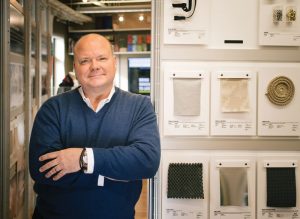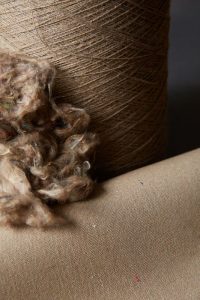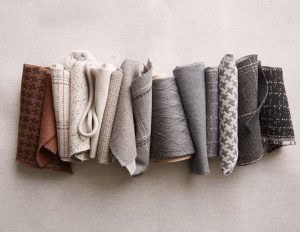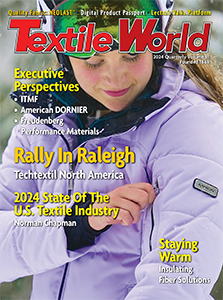
Glen Raven’s CEO Leib Oehmig discusses the company’s first corporate sustainability report, “Continuing A Pattern Of Good”
TW Special Report
Founded in 1880, Glen Raven Inc., Glen Raven, N.C., has grown from its cotton mill beginnings to a global performance textile leader offering branded fabrics including Sunbrella®, Dickson®, GlenGuard®, and Strata®. The company’s three divisions — Glen Raven Custom Fabrics, Glen Raven Technical Fabrics and Trivantage® — bring a wide variety of upholstery, marine, technical shading, automotive, military, geotextile and protective workwear products to the marketplace.
Today, Glen Raven is global with locations in 23 countries and sales in more than 120 countries.
The company recently issued its first Corporate Sustainability Report (CSR), titled “Continuing A Pattern Of Good.”
“As the world evolves, we feel it is important to be more transparent about our actions, acknowledge the work we’ve done and continue to challenge ourselves to be an even stronger champion of sustainability,” Glen Raven’s CEO Leib Oehmig said about the CSR. “We owe it to future generations to continue to be a business that demonstrates success while contributing to the greater good of our planet.”
The report establishes baseline metrics across two foundational pillars:
- Pillar 1 – Supporting Our People and Communities; and
- Pillar 2 – Sustaining Our Planet
Each pillar focuses on four key areas — associates, communities, environmental impact and circular economy.
Textile World recently had the opportunity to speak with Oehmig about Glen Raven’s first CSR.
TW: What prompted GR to issue a report this year?
Oehmig: If you know Glen Raven well, you know this is not something that we have felt compelled to do. Glen Raven doesn’t seek publicity or seek credit for the work we do. We’re really about the work and doing the right thing for all of our stakeholders, whether that is our customers, associates or suppliers. But our stakeholders now want to know. They want us to be more transparent and want us to hold ourselves more accountable. Glen Raven
is clearly interested in this because it will make us a better company.

TW: In reviewing Glen Raven’s Corporate Sustainability Report, it is clearly both detailed and comprehensive with a high level of employee involvement. Is there a financial metric that comes into play with selecting which programs will be implemented and on what timelines?
Oehmig: At Glen Raven, one of the privileges we have as a privately-held company is that we can take a long-term view. Financial metrics are not top of mind when we start thinking about how we’re going to impact all the communities that we serve, our customers, or
our employees. What we do believe, is that if we stay true to our values and we do the things that are right for all of our stakeholders, business success will follow.
These things are so equally important to us — built around leadership and safety and volunteerism, and certainly sustainability — and we will find a way to bring things along together.
This is a journey, but we want to have a high level of urgency surrounding all of the goals.
TW: Glen Raven is known for innovation and is a past recipient of the Textile World Innovation Award. What technology advances do you see having the greatest impact on the company’s sustainability goals?
Oehmig: Equipment manufacturers are making investments and they are thinking about the same things that we are. We work hand-in-hand with them and have partnerships with our suppliers — and I’m not speaking just for textile processing, but all things related to our broader textile manufacturing processes — and are working together on how to make the process more efficient, create less waste and consume less energy. Even in our building construction. Our last major greenfield project, which was our distribution center — and people generally don’t think much about a distribution center and a warehouse — but it was important to us that that project be LEED [Leadership in Energy and Environmental Design] certified. We keep that top of mind in everything that we do, and for our projects going forward, we’ll continue to work hand-in-hand with our contractors, system providers and all of our equipment providers to make sure that we are leading in terms of the equipment we are deploying.
I also want to say that a large part of our focus over the past decade has been on reducing waste and reducing waste streams with a goal of having all of our global operations producing no waste that ends up in a landfill. We’re still on that journey, but we are very close. Part of that is reducing the materials that we use and also providing other applications and creating other products to utilize those waste streams.

Through some innovation, new technology and our design work, we’ve been able to take these waste streams and create beautiful products from them. In 2020, we launched our RETWEED Collection, which is part of our Renaissance fabric program that began in 2008. And it’s interesting —we wanted to be able to utilize our waste streams and have products that were created with a high level of recycled content and we thought it was something that would really resonate with our customer base, which it did. But what was also interesting was the design elements that resulted [The composition of Renaissance yarns results in the occasional natural variation in shade or specks of color that add to the visual interest of the fabric]. People were choosing those products as much for the aesthetic value as they were for the environmental consciousness that went into creating them.
In 2009, we created the Recycle My Sunbrella program. To date, we have processed nearly 1 million pounds of waste into new products through this program. We want to double that utilization by 2025. We have such momentum and are very comfortable with that goal. But the point is, all of this is something that we have been focused on for well over a decade now as it relates to these recycled waste streams, which goes into this broader picture of “How do we become less impactful on the environments in which we operate?”
TW: Merit, opportunity and inclusion have always been central to Glen Raven’s culture. How can you ensure the diversity goals continue to support these tenets?
Oehmig: If you look at Glen Raven’s ethos, something fundamental to us is a heart for people. We believe having a different point of view and bringing all those viewpoints together makes you better. And we’ve learned that in many ways, but definitely through globalization. As the company has created a global footprint and really embraced the cultures and communities in which we operate, we have seen the value that is created when you bring different points of view together with a single-minded focus on pushing the business forward and continuing to do good things. We want to elevate that and expand that idea. Diversity is something that we haven’t always thought about in terms of just diversity. We thought about it in terms of “How do we bring a group of people together with a range of life experiences, a range of work experiences and a range of points of view all based in what is foundational to Glen Raven’s values so we can work together and
create something special?” We have seen the benefits of that throughout the company’s history, and we want to elevate and accelerate that. We felt like making our goals around diversity and inclusion more transparent will not only challenge us, but will also hold us accountable for achieving those goals and exceeding them.
TW: Many of the sustainability initiatives set 2025 as the targeted timeline. Is this aggressive, or representative of the current level of momentum and progress?
Oehmig: We’ve had so many of these practices in place throughout Glen Raven’s history and definitely have great momentum around these initiatives. Most of the efforts are already in flight and have been in flight for a long time. So now it’s just driving a stake in the ground and holding the company accountable to not only those goals, but really to exceed those goals. And Glen Raven is perfectly comfortable with the timeline, and we’re confident we will exceed the goals that we have established.
TW: How does sustainability impact Glen Raven’s multi-phase, global expansion plan?
Oehmig: To the extent that the sustainability report would impact our capital investment plans, it really is just informing those plans. When our engineers are meeting contractors, and our manufacturing engineers are meeting with the equipment manufacturers, we’re talking through these same opportunities in their development and asking what we can do differently and what can we do to lean in and do to really push technology in support of our sustainability reporting. Our partners have been very supportive. Everybody has a role in this whatever position you play in the total value chain.
It’s going to take all of us working together in order to have the greatest impact both in the communities and on the planet.
TW: How do you see Glen Raven’s position in the industry as it relates to corporate responsibility?
Oehmig: If a company like Glen Raven is leading a collaborative effort and working with our equipment manufacturers and our raw material suppliers and informing and educating and trying to create new innovations that may address many of the issues we are facing, that’s a position we’d like to be in.
We all have our intellectual property that we seek to protect. But at some point, you have to find a balance. We have people in this industry who are very talented and we’ve got to figure out a way to work together to have a positive impact on the future.
May/June 2021




